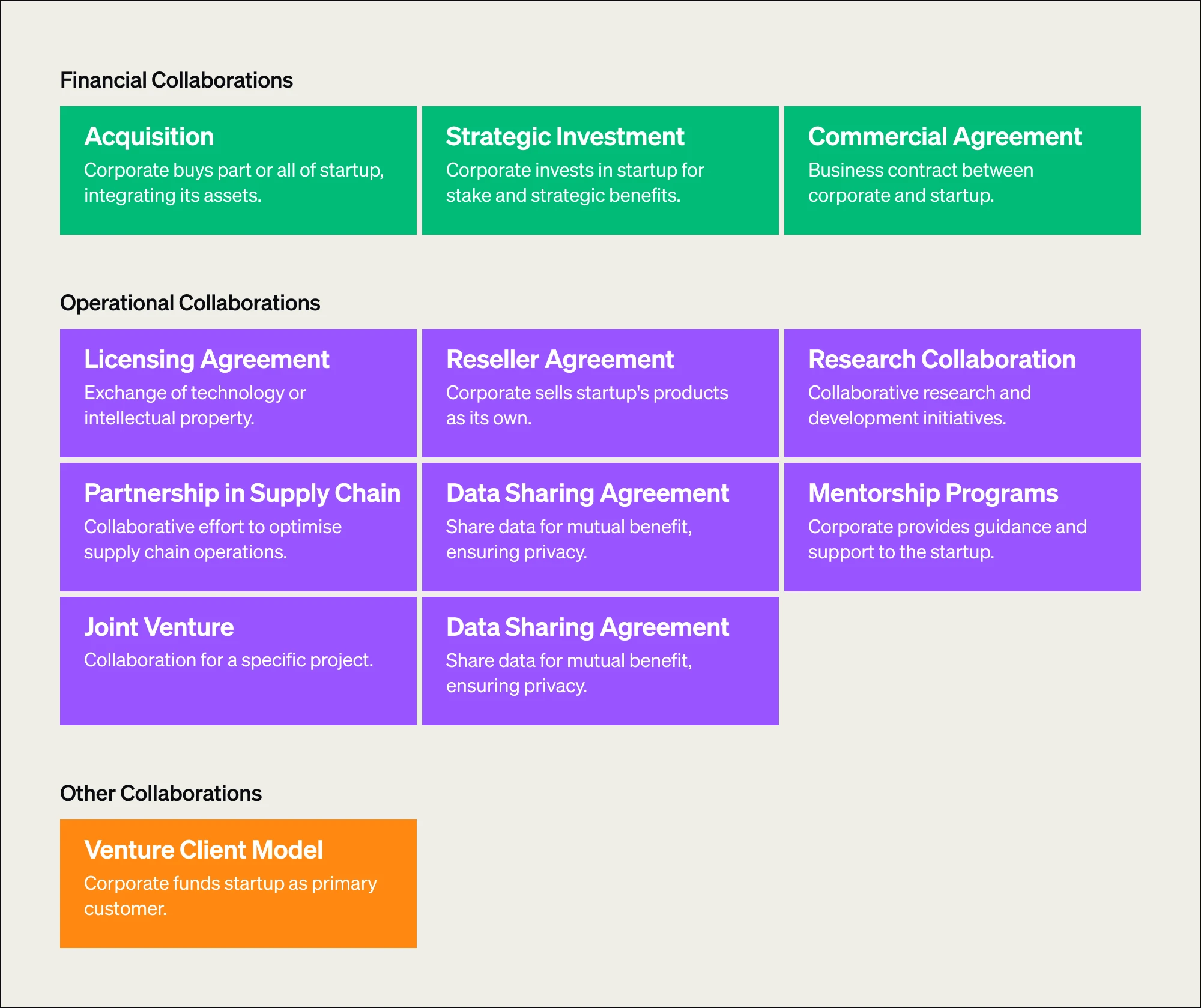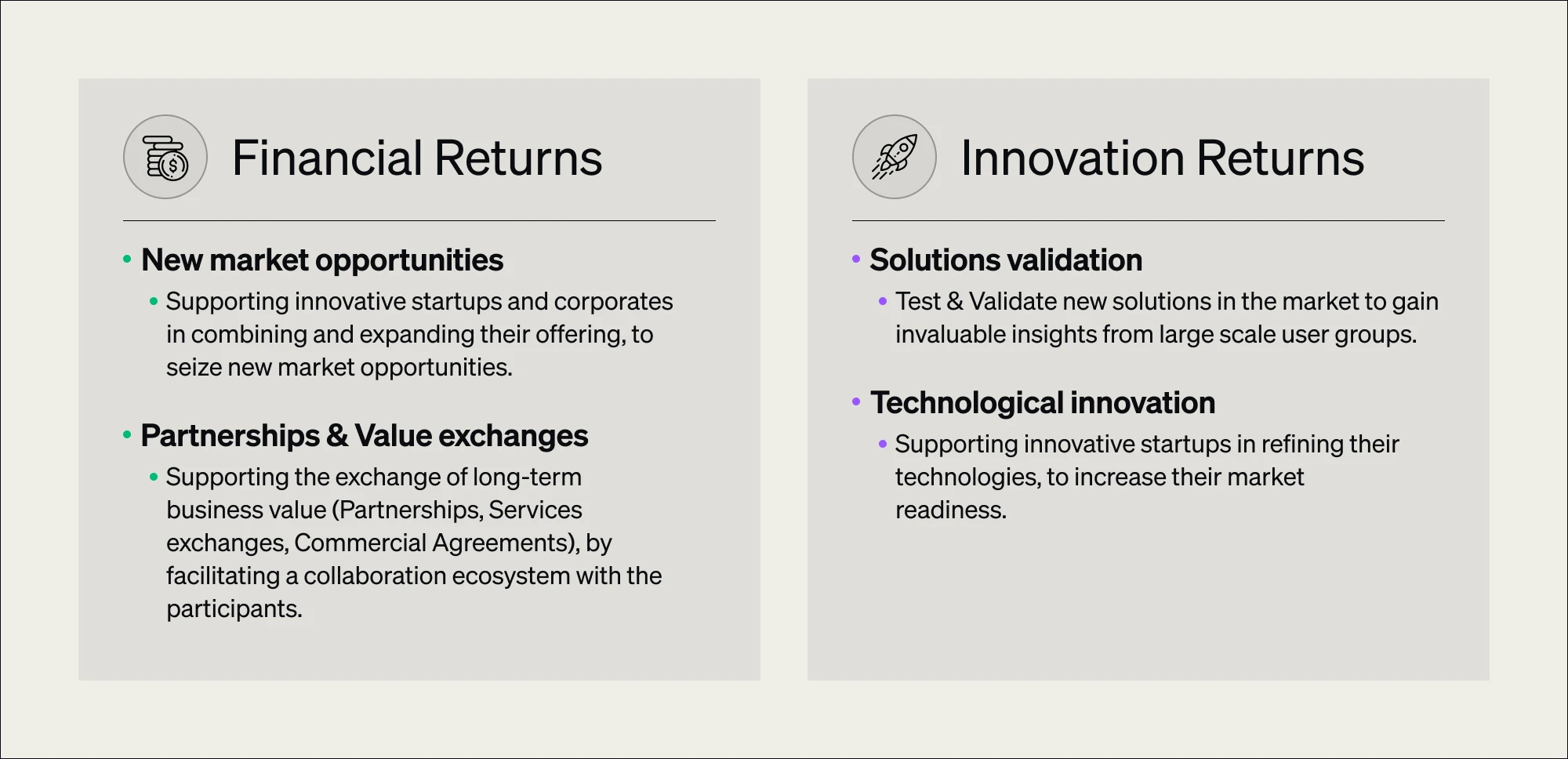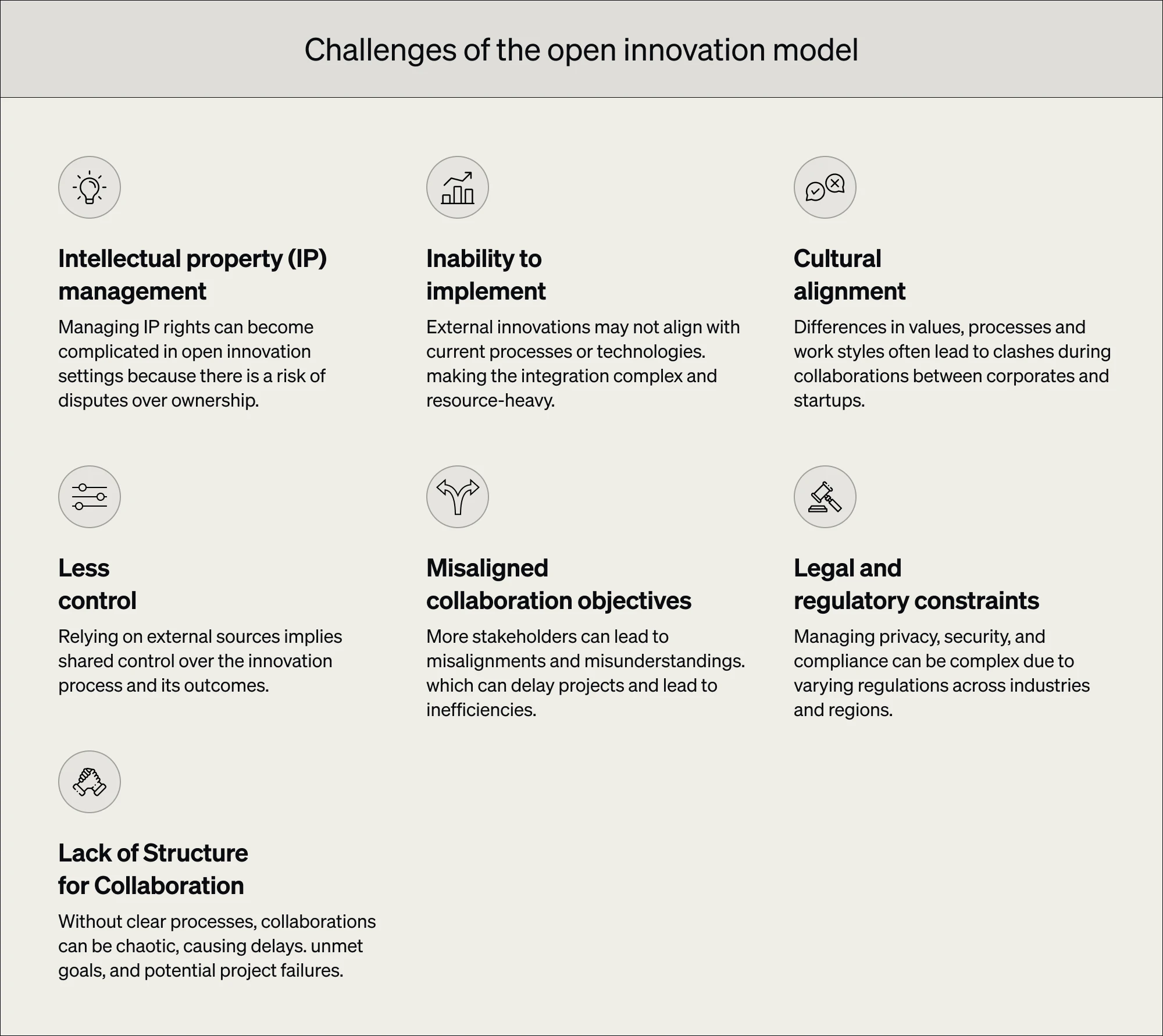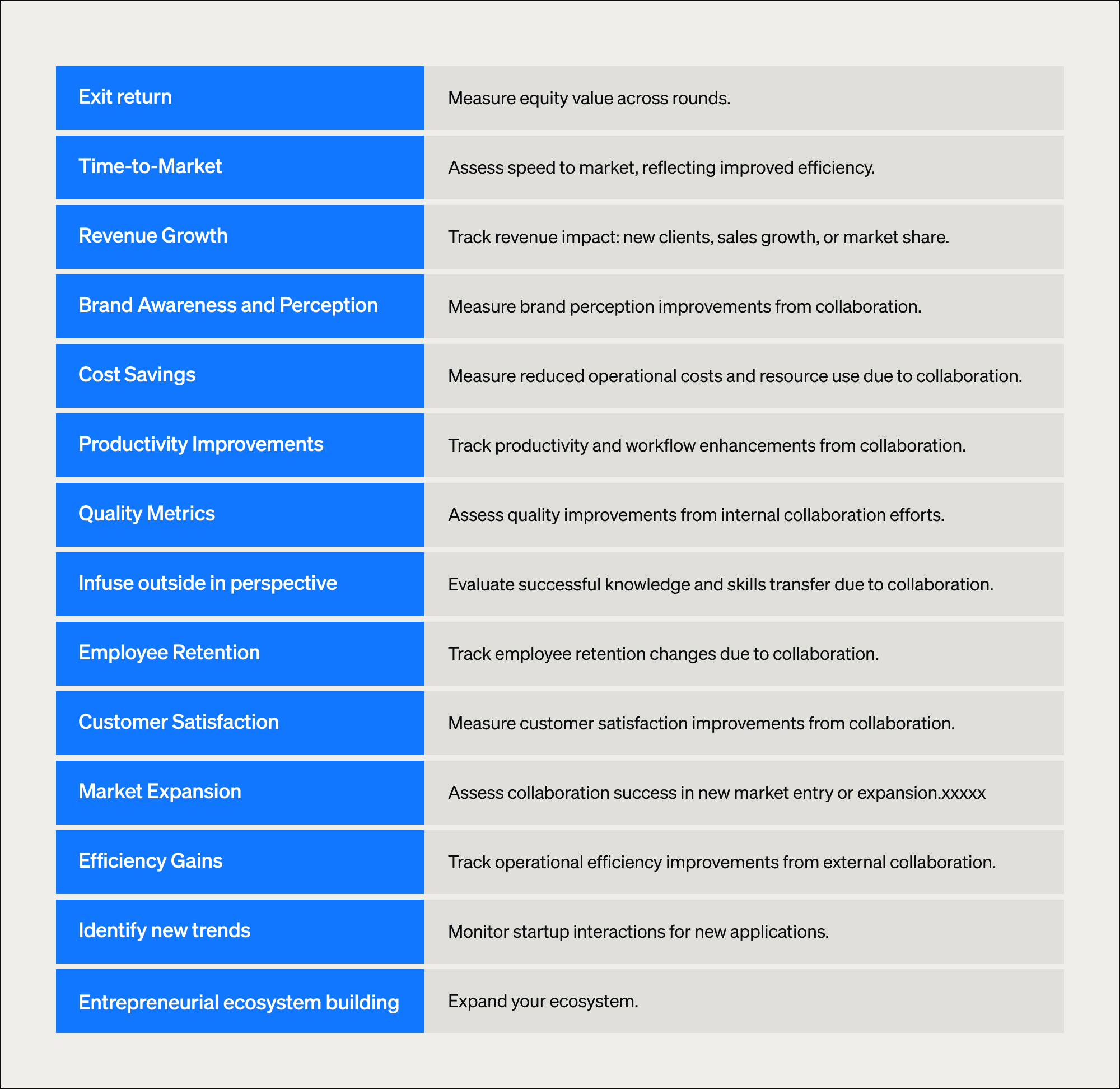Open Innovation: An Introduction
Companies like Bosch, Unilever, Siemens, Google and more have leveraged the open innovation model to tap into the external startup ecosystem and access new ideas, technologies, and expertise—all while capitalising on their existing assets.
It’s a collaborative approach that allows businesses to:
- Accelerate the development of new products and services
- Tap into external expertise and technologies
- Foster a culture of continuous improvement
- Enhance their competitive edge
- Build an ecosystem of different types of external partners
We've created this comprehensive guide to give you a better idea of how open innovation works in practice, its benefits, and how to implement it effectively.
What is open innovation?
Open innovation is a strategic approach that involves leveraging both internal and external ideas, knowledge, and technologies to drive innovation and create value. Unlike traditional innovation approaches that rely solely on in-house resources and R&D, open innovation encourages collaboration with external entities, including:
- Startups
- Customers
- Suppliers
- Research institutions
- Competitors
The approach accelerates innovation by leveraging collective intelligence to fuel the creation of groundbreaking technologies, business models, products and services.
Now that we’ve covered some basics, let’s take a closer look at how open innovation differs from the more traditional “closed innovation” model.
Open innovation vs closed innovation
Open and closed innovation represent two different paradigms for tackling the innovation process:
- In closed innovation, companies use their own internal resources to innovate, keeping the process in-house.
- In open innovation, companies tap into the external landscape, accessing new ideas and technologies through collaboration and partnerships.
Each approach has its own set of strengths:
- Open innovation offers higher flexibility and access to a broader range of technologies and talent, which can lead to faster innovation cycles.
- Closed innovation offers tighter control and potentially stronger proprietary positions but may be slower and more costly due to its reliance on internal resources only.
For some years now, the open innovation model has been gaining popularity as a superior way to fuel innovation while keeping internal costs low, speeding up the time to market and decreasing risk by sharing it with partners.
Here are some of the key differences between the two approaches:
Knowledge Flow
Closed Innovation
All R&D is internal. Companies rely on their own research staff and resources.
Open Innovation
Integrate external technologies or outsource certain R&D aspects to accelerate innovation.
Control
Closed Innovation
Businesses control their intellectual property (IP) and development processes strictly.
Open Innovation
IP can be shared with partners (shared, sold, or licensed), and companies can tap into externally available IP as well.
Process
Closed Innovation
Ideas are generated, developed, manufactured, marketed, and sold using internal resources.
Open Innovation
Dynamic and iterative, with ideas coming from partners, customers, academia, or even competitors.
Risk
Closed Innovation
High levels of investment in R&D are required, as the company bears all the costs and risks.
Open Innovation
By leveraging external resources and partnerships, companies can potentially reduce costs and risks.
In most cases, the choice between open and closed innovation will depend on each company’s industry, culture, size, and the nature of the markets it serves. Most companies use a blend of both models to optimise their innovation strategies.
Open innovation vs corporate accelerators: What’s the difference?
Both corporate accelerators and open innovation are strategic approaches used to innovate, boost growth and gain a competitive edge. While they are distinct concepts, they both emphasise the value of:
- External collaboration for innovation purposes
- Leveraging existing corporate assets to nurture external partnerships
Let's take a look at each strategy individually.
What is it?
Open Innovation
A strategy that leverages external sources of technology and innovation to complement and enhance internal R&D efforts. It involves companies reaching out to partners, universities, customers, startups, and even competitors to co-create value.
Corporate Accelerators
Partnership programs set up by corporations to engage and partner with startups. They often provide funding, mentorship, office space, and other resources in exchange for equity in the startup
What’s its purpose?
Open Innovation
- Speeding up the innovation process
- Reducing costs associated with R&D
- Accessing diverse ideas and talents
Corporate Accelerators
- Access to new solutions and technologies
- Early engagement with potential disruptors
- Introducing an entrepreneurial mindset into the corporation
Think of corporate accelerators as a mechanism for open innovation. While open innovation opens the door to external collaboration, corporate accelerators help integrate this external entrepreneurial spirit into the corporation's core through a structured and ongoing program.
12 accelerator collaboration models
Corporate accelerators use various collaboration formats to engage with startups, each tailored to achieve specific strategic goals. Here’s a quick breakdown of some of the most commonly used models:

Each of these collaboration formats offers distinct advantages, so make sure to choose a model that can be tailed to your unique objectives, corporate growth goals and return targets.
Financial returns vs innovation returns
When developing an open innovation strategy, it’s important to consider the type of returns you’re aiming for (i.e. financial or innovation returns?). While both types of returns are beneficial, its a good idea steer your efforts in the direction of the specific goals you wish to achieve.
The financial returns pathway
The financial pathway focuses on investing in startups, scaling them and producing financial returns through exists. Accelerators are useful in this scenario because they help startups refine their business models, speed up their growth, and achieve a level of maturity needed to attract further investment or prepare for a successful exit.
Examples of collaboration models in this pathway include:
- Money-for-equity
- Resources-for-equity
- Convertible loan
Useful key performance indicators (KPIs) for this pathway include:
- Follow-on funding: The amount ofl investment startups receive after initial funding.
- Portfolio company valuation: The total value of all ventures in the accelerator’s portfolio.
- Startup survival and exit rates: The number of startups that remain operational or are sold after 1, 2, or 3 years.
The innovation returns pathway
The innovation pathway focuses on integrating startups into larger corporate structures to spur on-the-ground innovation. This integration often results in the development of groundbreaking products and services that can significantly enhance a company’s offerings.
Examples of collaboration models in this pathway include:
- Warrant
- Money-for-equity
- Resources-for-equity
- Non-equity deal
KPIs for this pathway include:
- # of joint efforts: The number of collaborative projects.
- # of integrations: The number of ventures successfully integrated.
- Impact on business unit: Tangible benefits e.g. increased efficiency or new capabilities.
- Additional revenue or businesses created
- # of startups that survived, existed or after 1, 2, or 3 years
Here’s an example of how open innovation vehicles like accelerators can help you achieve both financial and innovation goals:
EntertainmentLAB
Entity: Accelerator
Founded: 2023

EntertainmentLAB is shaping the future of entertainment by connecting the brightest startups across the globe with top corporate players. It identifies, develops, and integrates new products an services into the value chain and/or ecosystems of its corporate partners.
Here’s how EntertainmentLAB delivers both financial and innovation returns:

3 open innovation models
There are several types of open innovation models, each catering to different strategic needs and contexts:
Outside-in open innovation
Outside-in open innovation involves companies actively sourcing new ideas, processes, and insights from external entities, including startups, research institutions, universities, customers, and even competitors. The goal is to bring external knowledge and technology into the company to complement and enhance its own capabilities, speed up innovation, improve existing offerings and reach new markets.
Examples of this approach include:
- Corporate startup collaborations: Partnerships between corporations and startups.
- Crowdsourcing: Gathering ideas, content, or services from a larger community.
- IP licensing: Allowing the use of IP in exchange for a fee or royalty.
- Hackathons: Events to collaboratively solve a problem in a short timeframe.
- Innovation challenges: Competitions to solve specific problems, often in return for prizes or collaboration opportunities.
Inside-Out Open Innovation
This model focuses on leveraging and monetising internal assets like ideas, IP or technologies by licensing, selling, or spinning them off to external partners. The approach enables companies to capitalise on existing assets and resources while leveraging the expertise of external partners to bring new products and services to market.
Examples of this approach include:
- Incubators: Business units that support new ventures from concept development.
- Out-licensing: Granting the right to use IP in exchange for a fee or royalties.
- Joint ventures: When two or more parties partner to develop a venture.
- Spin-offs: Creating independent entities from existing business units or technologies.
Coupled Open Innovation
Coupled open innovation combines the inbound and outbound models. This model often takes the form of strategic alliances, joint ventures, or partnerships in which both entities contribute and benefit from shared intellectual property. The key to success in this model is ensuring a balance of give and take that aligns with the strategic goals of each party involved.
Examples of this approach include:
- Innovation ecosystems: Networks of interlinked entities (e.g. companies, startups, universities, government entities, etc.) that collaboratively contribute to and benefit from collective innovation efforts.
- Strategic Alliances: Partnerships with others in the industry or in complementary fields to co-develop products, share technologies, and collaborate on research initiatives.
- Consortia: Groups of companies that operate in the same industry or face similar technological challenges form consortia.
What are the building blocks of open innovation?
Crowdsourcing and external perspectives
Crowdsourcing through open calls can yield unexpected and valuable insights from a broad spectrum of contributors. This involves issuing open calls to external communities, inviting them to contribute ideas or solutions to specific challenges. The approach leverages the collective expertise and creativity of a wider audience, leading to a more comprehensive and inclusive innovation process.
Strategic alliances, networks and knowledge-sharing
Building networks and strategic partnerships with startups, research institutions, and industry experts enables companies to leverage cutting-edge ideas, technologies, strategies and expertise, enhancing their capabilities and leading to more effective solutions to complex challenges.
Cross-industry ecosystems
Engaging in collaborations across different industries to exchange ideas and explore innovative solutions can lead to valuable breakthroughs. By combining diverse expertise and perspectives, companies can build broader ecosystems that include various players and innovation vehicles, including incubators, accelerators, venture arms and more.
End-users as co-creators
Involving customers in creating and developing new products and services helps ensure you’re launching offerings your target audience will love. By soliciting their feedback, preferences, and insights, you can tailor your products and services ensuring their profitability and reducing risk.
The advantages and challenges of open innovation
Advantages of the Open Innovation Mode

Access to a wider pool of ideas
Open innovation allows companies to tap into a broader range of ideas and technologies beyond their internal resources, leading to a faster, more efficient and more profitable innovation process.
Reduced costs and reduced risks
By collaborating with external partners, companies can share the financial and operational risks of research and development. This can lead to cost savings and more efficient resource use.
Quicker time to market
Leveraging external innovations can speed up the development process, enabling companies to bring products and services to market more quickly than if they were relying solely on internal capabilities.
Increased flexibility
Open innovation provides companies with access to essential tools and resources, enabling them to pivot or scale their operations quickly. This adaptability ensures they stay responsive to emerging market changes and evolving customer expectations.
A competitive edge
Open innovation can lead to highly valuable collaborations and partnerships that generate cutting-edge products and services. The influx of new ideas, technologies and expertise can also help companies bring new offerings to the market faster, creating a first-mover advantage over the competition
Challenges of the Open Innovation Model

Intellectual property (IP) management
Managing IP rights can become complicated in open innovation settings because there is a risk of disputes over ownership. Companies should establish clear agreements to protect their interests during collaborations.
Inability to implement
External innovations may not align with current processes or technologies, making the integration complex and resource-heavy.
Cultural alignment
Large companies typically have formal, risk-averse cultures and slower decision-making processes, while startups embrace lean and agile innovation processes and take bigger risks. These disparities can lead to clashes during collaborations.
Less control
Relying on external sources implies shared control over the innovation process and its outcomes. Companies might find themselves dependent on external entities when making critical decisions about how to tackle new technologies or innovations.
Misaligned collaboration objectives
Effective communication and coordination are essential in open innovation, especially when multiple stakeholders are involved. Misalignments and misunderstandings can delay projects and lead to inefficiencies.
Legal and regulatory constraints
Navigating privacy, security, and compliance issues can be challenging as these may vary greatly across industries, markets and geographic regions.
Lack of structure and/or process for collaboration
Without a structured process, collaborations can become disorganized, leading to missed deadlines, unmet expectations, and potential failure of the innovation initiatives.
Examples of successful open innovation cases

BMW
Initiative: BMW Open Innovation
BMW’s open innovation efforts include connecting with startups, research institutions, and other external partners to foster collaboration and co-creation of innovative solutions. They focus on unlocking the innovation potential of entrepreneurs, cross-industry technologies, intrapreneurs and innovation crowds in areas like automotive technology, digitalisation, sustainability, and mobility services. They have several entities dedicated to helping them achieve this goal, including BMW Startup Garage, BMW Crowd Innovation, BMW Technology Scouting, BMW Accelerator and more.
What makes this a good example of open innovation?
By fostering partnerships with diverse external entities, BMW is integrating new ideas and technologies with high potential into its offerings, diversifying its portfolio, creating new sources of revenue and maintaining its competitive edge in the market.

Bosch
Initiative: Bosch Open Innovation Partnerships
Bosch Open Innovation Partnerships fosters collaboration with startups and external innovators to develop new technologies and solutions in areas like IoT, mobility, automation and smart technologies. Participants who are chosen for the program gain access to Bosch’s extensive resources, mentorship, and access to its global network, facilitating the rapid development and integration of cutting-edge solutions.
What makes this a good example of open innovation?
The Initiative leverages external expertise and new perspectives, accelerating innovation and enhancing Bosch’s product portfolio. By partnering with startups, Bosch is integrating innovative (and potentially disruptive) technologies into its offerings, driving advancements in connected devices and smart solutions while fostering a dynamic ecosystem of innovation.
10 tips for successful open innovation
Define clear goals and targets
Set clear and attainable objectives to work toward. This will serve as the foundation for you to build your innovation strategy and find external partners with the same goals. Useful questions to consider at this stage include:
- What challenges do you want to tackle?
- What type of innovation do you want to take on?
- What results do you want to reach?
Whether it's improving existing products, exploring new markets, or solving specific challenges, having clear goals will help you direct your efforts effectively.
Build a diverse network
Engage with a wide range of external partners to diversify your sources of innovation. Potential partners can include startups, universities, research institutions, and customers (among others). Consider the following questions:
- Who can provide the unique insights and skills we’re looking for?
- How can we leverage different types of external expertise?
- Which partners align with our innovation goals?
Building a diverse network will bring in a variety of perspectives and innovative ideas, enriching your innovation efforts.
Encourage entrepreneurship and collaboration
Cultivate a culture of collaboration and openness throughout your organisation by encouraging both internal and external teams to share knowledge and actively participate in open innovation activities. Questions to think about at this stage could be:
- What types of rewards will encourage participation?
- How can we recognise outstanding contributions?
- What incentive structures align with our innovation goals?
Recognising and rewarding contributions fosters a more engaged and motivated innovation ecosystem.
Find and leverage the right digital tools
By carefully selecting and leveraging the right digital tools, companies can facilitate seamless communication to better manage the complexities of multiple innovation projects. Here are a few examples of tools that can come in handy:
- Idea Management: Platforms like IdeaScale, Brightidea, and Spigit allow you to collect, evaluate, and prioritise ideas from employees, partners, and customers.
- Knowledge Sharing: Platforms like Confluence, SharePoint, and Google Workspace facilitate knowledge sharing by centralising research and project information.
- Prototyping and Testing: Tools like InVision, Sketch, and Figma are excellent for design and prototyping, allowing teams to create and test prototypes quickly.
Make sure to choose tools that are suited to your specific needs and goals.
Protect your IP
Establish clear guidelines to help manage and protect your intellectual property (IP) during collaborations. This can include setting pre-established agreements like IP licensing and joint ownership models. To help guide the process, consider the following questions:
- What are the IP risks, and how can we mitigate them?
- What IP ownership model aligns best with our goals?
- What legal protections do we need in place?
Having these protections in place and making them transparent to partners can prevent potential conflicts later on.
Implement agile processes
Agile processes promote flexibility, rapid prototyping, iterative testing, and quick incorporation of feedback, all of which are essential for successful collaboration with external partners.
The approach focuses on regular communication and feedback loops, allowing for the swift integration of diverse perspectives. This approach encourages experimentation, aligns efforts with strategic goals, and ensures that innovations meet real-world needs, making the entire process more efficient and responsive to change.
Attract and engage the right partners
Invest time and effort in attracting and engaging with the right external partners. Potential characteristics to seek out include:
- Alignment with your growth and innovation goals
- Complementary expertise
- Similar values, mission and vision
By carefully identifying and engaging the right partners, you can boost your innovation efforts through effective collaboration and shared objectives.
Be transparent
Transparency and trust are crucial in successful partnerships, helping to ensure alignment and clarity throughout the collaboration process. Clearly defined roles, responsibilities, and expectations enable all stakeholders to move forward with confidence and clarity. Questions to consider include:
- How can we keep all parties informed about progress?
- What channels will facilitate effective communication?
- How do we handle feedback and concerns?
Regular updates and clear communication channels ensure that all stakeholders are aligned and informed.
Use the right success metrics
Structure and select metrics that match your overarching open innovation strategy, going beyond the traditional financial markers of success. Consider the questions below to help guide the process:
- What key performance indicators (KPIs) do we need to track?
- How can we gather and analyse relevant data?
- What adjustments can we make based on our findings?
Using KPIs to assess your progress will help you make data-driven decisions and improve your strategy as you move forward. Useful metrics to measure the success of your collaborations include:

Learn and Adapt
Be prepared to learn from both successes and failures and adapt your strategies accordingly. Stay up to date on what’s happening in your markets and be ready to adapt quickly based on your learning and any emerging trends or opportunities. Consider the following questions to guide the process:
- How can we create a culture of continuous learning?
- What mechanisms can we use to capture lessons learned?
- How do we iterate our innovation strategy?
Adapting based on feedback and results will help you stay ahead of potential challenges and improve your chances of successful outcomes.
Is open innovation right for you?
When executed the right way, open innovation can be a powerful strategy, helping companies fuel growth, agility and their competitive edge. By tapping into multiple external sources for new ideas, insights and concepts, businesses can access new technologies, develop new offerings, and enhance their market reach - all in a fraction of the time and with less risk.
The model is particularly valuable for companies looking to expand their reach or streamline their R&D without exponentially increasing internal costs.
If you’re wondering whether open innovation is the right move for you, be sure to contact us. We’d love to help guide you through the process.
_________
Looking to implement your own open innovation strategy? We can help you build a practical roadmap that leverages your unique corporate assets to make it happen.







